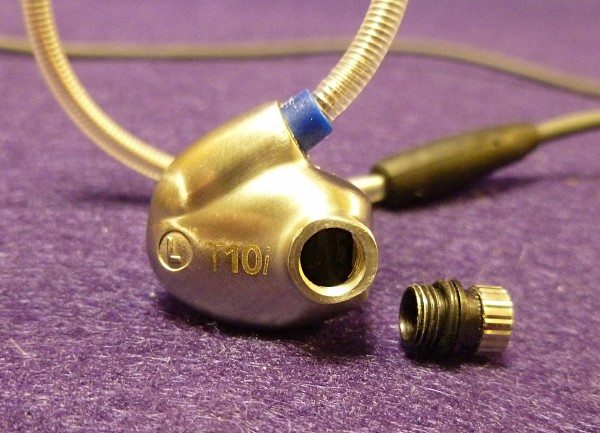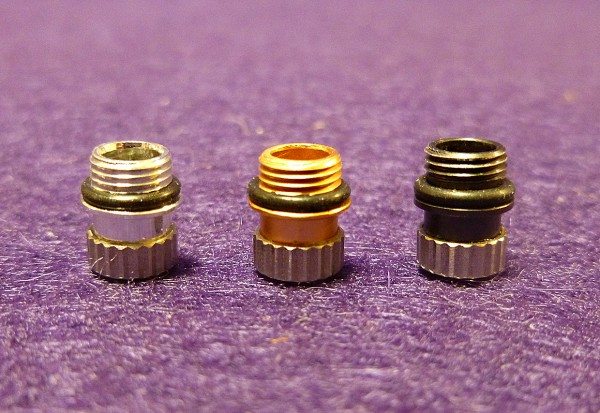Every time I write about Reid Heath Acoustic’s (RHA) in-ear headphones, it’s always about their “next big thing.” Each model seems to trump the previous one in interesting ways. Nice to see that nothing’s changed with RHA. Their new flagship earphone, the T10i (the i denotes a mic) certainly trumps everything before it. But this time, the differences are much bigger and better than before.
RHA’s T10i is a visual departure from previous models. Their previous flagship—the MA750i—is made from machined stainless steel resulting in amazing quality, especially considering its price. The T10i isn’t just an improvement on the MA750i, it’s a completely new in-ear headphone in every way. RHA went back to the proverbial drawing board and re-thought everything they had done up until now.
Where the MA750i was like a fine chiseled piece of metal, the T10i is organic looking, with its rounded, more ergonomic fit. There’s a retro/Gotham look to them. They feel good in the ear and are the most secure feeling earphones RHA has made so far.
Now this is where it gets interesting: The T10i in-ear headphones are made from injection-molded stainless steel. Why is that interesting? This process has never been done before with earphones. RHA uses powdered steel (yes, it exists) mixed with plastic—then molds it into its final shape. It is then heated to dissolve the plastic completely leaving only metal. It’s heated a second time (almost to melting point) for 10 hours which increases durability. During this multi-step process of vaporizing plastic and curing, the earpiece shell shrinks 40%, so RHA has to make the earpiece much larger in order for the result to be sized right. This method also allows for a thinner shell leaving room for a larger dynamic speaker with more room for air movement. This attention to detail makes a difference in the final sound.
There’s also attention to detail in more mundane pieces. The stress points where the mini plug connects is covered in flexible wire that allows extreme bending while providing total protection against breakage. The T10i is a behind-the-ear design, which is a love it or leave it design. I like this approach, although it is more of a hassle if you have to remove the earphone many times as in an office environment with its constant interruptions. The wire that wraps around the ear holds its shape when you bend it. That’s a great feature, however, I’m not a fan of the wire’s thickness. I wear glasses and the eyeglass earpiece does not like to share space with the T10i’s wire in the limited space behind my ear. Although I would much prefer a thinner wire, it’s an issue I can live with.
The T10i comes with a mic for calls, volume and skip functions. It works as advertised, but I’m not a fan of earphone mics for smartphone calls but I do appreciate its other uses. The mic is designed for Apple devices only.
As I said, RHA is the first to use this method of construction, but they didn’t stop there. Rather than tuning the T10i in-ear headphones for one type of sound, RHA has included 3 sets of filters that will personalize the audio depending on mood, or type of music being played. There is a treble, reference and bass filter. Bass and treble are self-explanatory and reference simply means a neutral frequency response with little emphasis on anything. Reference is the filter to use if your preference is for music to sound as accurate as possible. While that sounds like what anyone would want all the time, it ain’t necessarily so. Music is personal and most people like it tweaked towards the lower end a bit—even thought they may not be aware of it. Sometimes music can sound too accurate, which can make the bass seem weak. Sounds contradictory, doesn’t it?
The idea of tunable filters is still a bit rare, but it’s getting more popular each year. Phonak used them in their outrageously expensive (and now discontinued) Audeo PFE 232 earphones and Torque offers up to six filters for their t103z earphone. Shure and Etymotic also offer filters of their own design. Similar in usability to Torque, RHA’s filters are simple to change. Just unscrew and screw back on—no tools required. They are color-coded for easy recognition: black for bass, gold/yellow for treble and white for reference. The unused filters can be screwed into a thick, metal template for protection when not being used.
Let’s go through each filter set.
The bass filter is—as I said—self explanatory. This filter accentuates the bass for those who really like bass. However, don’t mistake them as a quick way to make the T10i sound boomy. Far from it. The bass that is delivered through these filters is prominent, but not at the expense of the other frequencies. Unlike what Phonak did with their PFE 232 bass filter, RHA has refrained from allowing their bass filter to make the T10i in-ear headphones sound like a pair cheap, bassy earphones.
I really don’t like the T10i ’s treble filter; and for an unusual reason. There is plenty of detail and everything sounds OK, but after listening for 20-30 minutes, my mind wanders and I find it almost impossible to pay attention. I’ve tried and tried, but to my ears, any music I play with the treble filters becomes totally uninvolving and forgettable. The music feels far away. I didn’t say it sounds far away, it just doesn’t feel close enough for me to care. I apologize if this makes no sense, but to me, music occupies space and location in my head and it either feels close, far or somewhere in-between. With the treble filter, the music is not where it belongs.
Let me say here that others may like the treble filter and it’s OK. That’s what makes earphones with filters so cool. People can disagree, still use the same earphone and stay friends. So don’t go by my word on the treble filters. Try them for yourself and let your ears decide.
The reference filter is like the mama’s bed and porridge in the story, Goldilocks. It’s just right—not to bright, not too low. If you’re a fan of vocals, folk or classical music, this may be the filter for you. Interestingly, on songs with more bass, the reference filter lets that bass come through without coloring or boosting. That’s a good thing.
I did notice a bit of symbalance on a couple of songs, but I attribute that to the songs themselves. That tells me that the reference filter is more accurate than forgiving. If your music collection contains many lower resolution songs, you may want to stick to the bass filter to help mask this trait.
Gordon Lightfoot’s classic “The Wreck of the Edmund Fitzgerald” is a perfect song for the reference filter. This 70s ode to a famous shipping tragedy has that typical yocal-forward 70s mix. The reference filter makes this song sound as it should. It has a nice bass line, but it recedes somewhat compared to what a modern mix might sound like. What’s strange on this song is that the bass actually sounds better with the reference filter than it does with the bass filter. It became readily apparent that the bass filter muddled the bass to the point where it disappeared into the mix. It’s the accuracy of the reference filter that helped the bass sound more prominent than with the bass filter. Weird.
The exact opposite is true on Gram Rabbit’s dark song, “Devil’s Playground”. Lead singer Jessica Rabbit’s vocals come off as a tad harsh with the reference filter. The T10i’s bass filter not only smooths out her vocals, but adds more kick to the bass drum for added effect. This is a song that benefits from less accuracy with added bass.
While the selection of different filters helped each song choice sound its best, it can also be a hassle changing filters constantly. I recommend trying to match the filters to a mood rather than a particular song or album. it’s easier living with the T10i earphones when you can sit for a while without running to switch filters.
Ladytron is a group that been around for over 10 years, but all of their music is throughly modern in how it sounds. Bass and percussion is pushed right up front, sometimes at the expense of clarity that the T10i earphones can’t always fix . However, Ladytron writes killer hooks, which grab hold and don’t let go. The bass filter is a bit too much on this music—unless you’re into that, which I imagine most of their fans probably are. The song “Ghosts” is a good example of when bass is too much. The reference filters allow the bass to pack quite a punch, yet still be balanced with the mids and highs. Not so with the bass filters, but again, I’m sure that I am in the minority here. Just for fun, I switched to the treble filters and sure enough, I found myself mentally wandering a minute into the song.
As usual with RHA, there is a large selection of ear tips to fit almost any ear. And as usual with RHA, I had trouble with every one of them. It’s not them, it’s me. I have trouble with almost every brand and use a pair of tips I keep hidden away for such purposes. Included is a nice, zippered leatherette case with plenty of room for the earphones, filters and plenty of tips.
RHA has outdone themselves (again) with the T10i in-ear headphones. The combination of first-rate materials and construction combined with tuned filters is almost too hard to resist. They’re not cheap, but the price is understandable and practically a bargain when you consider what you get. Plus, there is a 3 year warranty, a rarity among earphone makers.
Once again, it’s going to be fun to see what RHA will do next.
Source: The sample for this review was provided by Reid Heath Audio (RHA). Please visit http://www.rha-audio.com/us/ for more info.
BERIBES Bluetooth Headphones Over Ear, 65H Playtime and 6 EQ Music Modes Wireless Headphones with Microphone, HiFi Stereo Foldable Lightweight Headsets, Deep Bass for Home Office Cellphone PC Ect.
7% OffSoundcore Anker Life Q20 Hybrid Active Noise Cancelling Headphones, Wireless Over Ear Bluetooth Headphones, 70H Playtime, Hi-Res Audio, Deep Bass, Memory Foam Ear Cups, Travel, Office, USB-C Charging
17% OffProduct Information
| Price: | $199.95 US |
| Manufacturer: | RHA |
| Pros: |
|
| Cons: |
|














